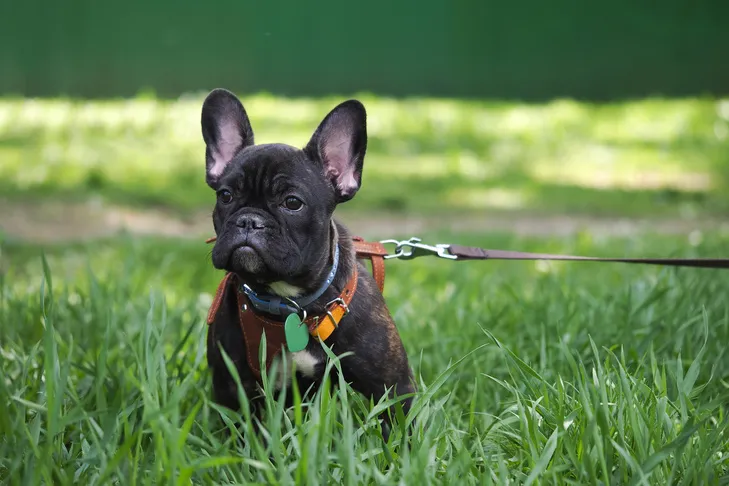Many dog owners assume their pets naturally know how to walk politely on a leash, but this essential skill requires proper training your dog to walk on a leash. Mastering it makes every outing enjoyable and stress-free. As a dog training expert featured in AKC Family Dog magazine, Kathy Santo shares proven steps to build a strong foundation for leash walking.
Begin with the basics to ensure your puppy associates the gear with positive experiences. For instance, if your dog shows signs of anxiety during walks that lead to pulling or distractions, consider resources like how to get my dog serviced for anxiety.
Introduce the Collar, Harness, and Leash
Start by acclimating your puppy to a comfortable collar, harness, or leash. Allow them to wear these items for brief periods indoors while engaging in play and offering treats. This turns collar-and-leash time into a fun association with rewards and attention, setting a positive tone for future sessions.
 French bulldog puppy in a harness sitting in tall green grass on a leash for a walk.
French bulldog puppy in a harness sitting in tall green grass on a leash for a walk.
Teach a Marker Cue
Select a consistent sound cue signaling an upcoming reward, such as a clicker, “yes,” or tongue cluck. In a quiet, low-distraction space with the puppy leashed, issue the cue. Reward immediately with a treat the moment they turn toward you or make eye contact. Repeat until they anticipate the cue by approaching eagerly. High-value treats enhance motivation during this phase of leash training puppies.
Encourage Following You
As your puppy moves toward you on the leash, back up several steps to encourage them to follow. Reward upon arrival, gradually increasing the distance. Sessions should remain short—5-10 minutes—to match a puppy’s attention span. Always end on a high note while they’re still engaged.
Practice indoors next, walking a few steps in a familiar room. The sensation of the leash provides initial challenge enough. Use praise and treats to reinforce staying by your side.
Transition to Outdoor Walks
Once indoor success is consistent, venture outside. New stimuli like scents, sounds, and sights will test focus, so keep initial walks brief and patient. Monitor closely: if distraction looms, use your cue, step away, and reward compliance. This proactive approach builds reliability in real-world loose leash walking.
Troubleshooting Common Leash Issues
Challenges arise as puppies mature and encounter novel environments. Aim for loose-leash walking to pass the Canine Good Citizen test and improve mutual comfort.
Handling Pulling
If pulling occurs, become a “tree”: stop motion until your dog returns to you. Avoid yanking or dragging. Tools like front-hook harnesses or head halters aid strong pullers. Dogs prone to obsessive behaviors, such as puppy keeps chewing on paws, may benefit from consistent leash routines to redirect energy.
Managing Lunging
Anticipate lunges toward triggers like other dogs or moving objects by redirecting with treats beforehand. Create distance and stay vigilant. Herding breeds may react more intensely, but proactive spacing works for all. Related issues like dog is biting and licking paws could signal underlying stress amplified on walks.
Addressing Barking
Barking at passersby often stems from insufficient exercise. Ensure age- and breed-appropriate mental and physical outlets. Counter by increasing distance from triggers and rewarding calm focus. For persistent cases mirroring my dog is constantly chewing on his paws, integrate more stimulation.
Over time, fade treats while randomly reinforcing good behavior. Keep some handy for maintenance.
Advanced handlers might explore train your dog as a therapy dog once basic leash skills solidify.
Consistent dog leash training transforms chaotic walks into harmonious adventures. Follow these steps patiently, and your puppy will walk politely beside you. For personalized guidance, connect with professional trainers via AKC GoodDog! Helpline for house-training, behavior, and beyond. Start today for happier outings!
